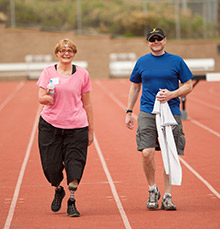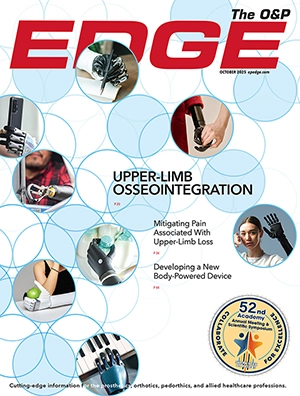Running May Reduce Risk of Death for Amputees Regardless of Duration, Speed

Running for only a few minutes a day or at slow speeds may significantly reduce a person’s risk of death from cardiovascular disease compared to someone who does not run, according to a study published in the Journal of the American College of Cardiology. This new information could be beneficial to amputees who may be at increased risk for health problems due to inactivity.
Exercise is well established as a way to prevent heart disease and it is a component of an overall healthy lifestyle, but it is unclear whether there are health benefits below the level of 75 minutes per week of vigorous-intensity activity, such as running, recommended by the U.S. government and World Health Organization.
Researchers studied 55,137 adults between the ages of 18 and 100 over a 15-year period to determine whether there is a relationship between running and longevity. Data was drawn from the Aerobics Center Longitudinal Study, where participants were asked to complete a questionnaire about their running habits. During the study period, 3,413 participants died, including 1,217 whose deaths were related to cardiovascular disease. In this population, 24 percent of the participants reported running as part of their leisure-time exercise.
Compared with non-runners, the runners had a 30 percent lower risk of death from all causes and a 45 percent lower risk of death from heart disease or stroke. Runners, on average, lived three years longer compared to non-runners. The authors concluded that to reduce mortality risk, promoting running is as important as preventing smoking, obesity, or hypertension. The benefits were the same no matter how long, far, frequently, or fast participants reported running. Benefits were also the same regardless of sex, age, body mass index, health conditions, smoking status, or alcohol use.
The study showed that participants who ran less than 51 minutes, fewer than 6 miles, slower than 6 miles per hour, or only one to two times per week had a lower risk of dying compared to those who did not run. DC (Duck-chul) Lee, PhD, lead author of the study and an assistant professor in the Iowa State University Kinesiology Department in Ames, said they found that runners who ran less than an hour per week have the same mortality benefits compared to runners who ran more than three hours per week. Thus, it is possible that more may not be better in relation to running and longevity.
Researchers also looked at running behavior patterns and found that those who persistently ran over a period of six years, on average, had the most significant benefits, with a 29 percent lower risk of death for any reason and 50 percent lower risk of death from heart disease or stroke.
“Since time is one of the strongest barriers to participate in physical activity, the study may motivate more people to start running and continue to run as an attainable health goal for mortality benefits,” Lee said. “Running may be a better exercise option than more moderate-intensity exercises for healthy but sedentary people since it produces similar, if not greater, mortality benefits in five to ten minutes compared to the 15 to 20 minutes per day of moderate-intensity activity that many find too time consuming.”
Unfortunately, amputees may avoid running for several reasons, including balance issues, a fear of falling, pain, and lack of access to appropriate prosthetic devices for running. For many, however, the potential benefits of running might make it worthwhile enough for them to seek solutions to these obstacles, pull out their running shoes, and give it a shot.
For information on numerous adaptive sports and recreation programs, some of which include running, as well as organizations that help amputees acquire adaptive equipment, visit Amplitude’s Resources webpage at www.amplitude-media.com/resources. Also visit the Calendar of Events at www.amplitude-media.com/calendar for dates of upcoming free mobility clinics where amputees can learn to run safely.
This article includes information provided by the American College of Cardiology.
This article is for informational and educational purposes and is not meant to substitute for medical advice from a qualified medical professional. Consult your healthcare provider before beginning any exercise program.



